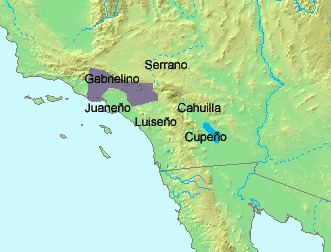Native to Southern California Extinct ca. 1900? | Ethnicity Tongva Revival from 2004b | |
 | ||
Region Los Angeles, Santa Catalina Island Language family Uto-Aztecan
Northern Uto-Aztecan
Serran
Tongva | ||
The Tongva language (also known as Gabrielino) is a Uto-Aztecan language formerly spoken by the Tongva, a Native American people who live in and around Los Angeles, California. Tongva is closely related to Serrano.
Contents
- Language revitalization
- Consonants
- Morphology
- The Lords Prayer
- Collected by C Hart Merriam 1903
- Collected by Alexander Taylor 1860
- Collected by Dr Oscar Loew 1875
- Collected by Charles Wilkes USN 1838 1842
- Other sources
- Toponymy
- References
The last fluent native speakers of Tongva lived in the early 20th century, but no evidence to this time and date can prove a fluent speaker in the last 150 years. The language is primarily documented in the unpublished field notes of John Peabody Harrington made during that time. The "J.P. Harrington Project", developed by the Smithsonian through UC Davis, his notes of the Tongva language, approximately 6,000 pages were coded for documentation by a Tongva member who took 3 years to accomplish.
There are claims of native speakers of Tongva who have died as late as in the 1970s, but there is no independent verification of these individuals having been fluent speakers.
Evidence of the language also survives in modern toponymy of Southern California, including Pacoima, Tujunga, Topanga, Azusa, Cahuenga in Cahuenga Pass, and Cucamonga in Rancho Cucamonga. Additionally, the minor planet 50000 Quaoar was named after the Tongva creator god.
Language revitalization
As of 2012, members of the contemporary Tongva (Gabrieleño) tribal council are attempting to revive the language, by making use of written vocabularies, by comparison to better attested members of the Takic group to which Tongva belonged, and by offering classes. The Gabrielino-Tongva Language Committee has created Tongva grammar lessons and songs, and a Tongva Facebook page "introduces an audio of a new word, phrase or song daily."
Consonants
The following is a list of the consonants and vowels of the Tongva language. In parentheses is the spelling of the specific sound. Note that there are multiple orthographies for the Tongva language and certain letters represent more than one sound, so certain sounds may have multiple ways to be spelled.
Morphology
Tongva is an agglutinative language, where words use suffixes and multiple morphemes for a variety of purposes.
The Lord's Prayer
The Lord's Prayer is called 'Eyoonak in Tongva. The following text was derived from old Mission records.
Collected by C. Hart Merriam (1903)
(Merriam refers to them as the Tongvā)
- Po-koo
- Wěh-hā
- Pah-hā
- Wah-chah
- Mah-har
- Pah-vah-hā
- Wah-chah-kav-e-ah
- Wa-ha's-wah-chah
- Mah-ha'hr-kav-e-ah
- Wa-hās-mah-hah'r
- Wa-hā's-mah-hah'r-koi-po-koo
- Wa-hā's-mah-hah'r-koi-wěh-hā
Collected by Alexander Taylor (1860)
- po-koo
- wa-hay
- pa-hey
- wat-sa
- mahar
- pawahe
- wat-sa-kabiya
- wa-hish-watchsa
- mahar-cabearka
- wa-hish-mar
Taylor claims "they do not count farther than ten"
Collected by Dr. Oscar Loew (1875)
- pu-gu'
- ve-he'
- pa'-hi
- va-tcha'
- maha'r
- pa-va'he
- vatcha'-kabya'
- vehesh-vatcha'
- mahar-kabya'
- vehes-mahar
- puku-hurura
- vehe-hurura
Collected by Charles Wilkes, USN (1838-1842)
- pukū
- wehē
- pāhe
- watsā
Other sources
Toponymy
The table below gives the names of various missions in the Tongva language.
